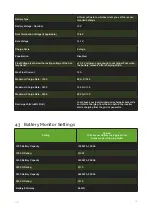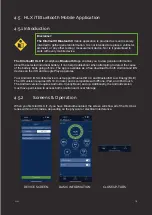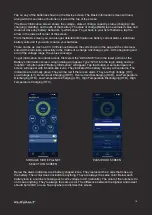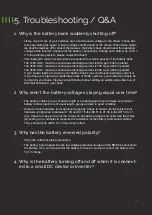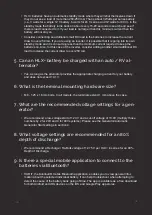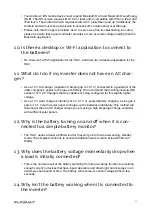
HLX+ batteries must be placed flat on their bottoms. Any other orientation will void the warranty.
Also, do not stack them one directly on top of another.
Batteries warm up while in use. Please consider your local average and seasonal temperature
when positioning your battery bank. If they will be in a warmer environment, you may want to leave
a minimum of one inch spacing between each of the batteries.
If they will be subjected to cold temperatures, you may want to place them as closely as possible
to each other. Consider adding insulation or an insulated enclosure around the batteries if they will
be exposed to temperatures that approach 32°F (0°C). The BMS will not allow charging when the
internal temperature is below freezing, and they will try to warm themselves using the charging
current Using insulation when it is cold will maintain more of the heat generated during normal
charging and reduce the chance of the BMS shutting the battery down to protect the battery cells.
Please note battery capacity is reduced by 20% as its internal temperature falls between room
temperature (approximately 77°F (25°C) and just above 32°F (0°C).
Please remember to remove the insulation in warmer months. Overheating the batteries will short-
en their life and the BMS will shut down the battery in temperatures above 149°F (65°C).
3.3 Cabling
All wire must be the appropriate gauge and construction to handle the loads that will be placed
upon it. Heavy gauge, fine stranded copper wire is the industry standard. A minimum of 2/0 or 4/0
AWG copper cable is recommended for battery interconnect cables.
The cables connecting batteries in series into rows must be the same length. The cables connect-
ing the rows in parallel must be the same length. The home run cables to the inverter must be the
same length. Cables of different lengths will cause voltage differences in your battery bank. The
rows in your battery bank must be kept within 0.2 V of each other to ensure that they work correctly
and that large currents between rows aren’t generated.
If your battery bank suddenly shuts down as one or more rows approaches fully charged or fully
discharged, it is likely either the batteries are not all at the same state of charge or, if they are mea-
sured with a multimeter to be all the same voltage, the voltage drop across the cables connecting
the rows is not equal. Also use the voltmeter to make sure that the voltage drops across each
battery interconnect is very close.
Torque all bolts and battery terminals to between 7.38 and 8.11 ft-lbs (88.51 to 97.36 in-lbs OR 10
to 11 nm). Terminals left insufficiently tightened will lead to overheating, melting the battery termi-
nals and potentially causing a fire. Be careful when using thin washers. You may think you're ap-
plying sufficient torque, but if the washers are too thin, the cable lugs can still move. Add additional
washers until you can tighten, and the cable lugs cannot move.
3.4 Configurations
The KiloVault® HLX+ series of batteries can be used in 12 V, 24 V, 36 V, and 48 V configurations
where one, two, three or four batteries are connected in series, plus to minus, in a row. The maxi-
mum number of batteries in a bank is sixteen, 4 in parallel strings of 4 batteries in series. Each row
of batteries must be kept within 0.2 V of each other or the battery bank may prematurely shut down
during charging and discharging. There are configuration limitations depending on the temperature
range of the installation location and whether or not you are using the HLX+ Bridge. The HLX+
Bridge helps the HLX+ batteries coordinate their heaters.
2022
5

















